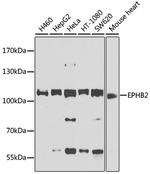Search Thermo Fisher Scientific
图: 1 / 1
EphB2 Antibody (PA5-97252) in WB

产品信息
PA5-97252
种属反应
宿主/亚型
分类
类型
抗原
偶联物
形式
浓度
纯化类型
保存液
内含物
保存条件
运输条件
RRID
产品详细信息
Immunogen sequence: PIGRCMCKAG FEAVENGTVC RGCPSGTFKA NQGDEACTHC PINSRTTSEG ATNCVCRNGY YRADLDPLDM PCTTIPSAPQ AVISSVNETS LMLEWTPPRD SGGREDLVYN IICKSCGSGR GACTRCGDNV QYAPRQLGLT EPRIYISDLL AHTQYTFEIQ AVNGVTDQSP FSPQFASVNI TTNQAAPSAV SIMHQVSRTV DSITLSWSQP DQPNGVILDY ELQYYEKELS EYNATAIKSP TNTVTVQGLK AGAIYVFQVR ARTVAGYGRY SGKMYFQTMT EAEYQTSIQE K; Positive Samples: NCI-H460, HepG2, HeLa, HT-1080, SW620, Mouse brain, Mouse heart; Cellular Location: Cell membrane, Cell projection, Single-pass type I membrane protein, axon, dendrite
靶标信息
EPHB2 is a receptor tyrosine kinase that belongs to the ephrin receptor family. Members of the Eph family of kinases play important roles in diverse biological processes including nervous system development, angiogenesis and neural synapsis formation and maturation. Based on their structures and sequence relationships, ephrins are divided into the ephrin-A (EFNA) class, which are anchored to the membrane by a glycosylphosphatidylinositol linkage, and the ephrin-B (EFNB) class, which are transmembrane proteins. The Eph family of receptors are divided into 2 groups based on the similarity of their extracellular domain sequences and their affinities for binding ephrin-A and ephrin-B ligands. Ephrin receptors make up the largest subgroup of the receptor tyrosine kinase (RTK) family. EphB4 binds to ephrin-B2 and plays an essential role in vascular development.
仅用于科研。不用于诊断过程。未经明确授权不得转售。
篇参考文献 (0)
生物信息学
蛋白别名: Developmentally-regulated Eph-related tyrosine kinase; EFL6; EFNB3; EK5; ELK-related tyrosine kinase; EPH B2; EPH tyrosine kinase 3; EPH-like kinase 5; EPHB3; Ephrin B1; Ephrin B2; Ephrin B3; Ephrin B4; Ephrin type-B receptor 2; EphrinB1; EphrinB2; EphrinB3; EphrinB4; EPLG8; ETK2; HEK-6; HEK2; LERK8; MGC87492; Neural kinase; Nuk receptor tyrosine kinase; protein-tyrosine kinase HEK5; Renal carcinoma antigen NY-REN-47; TYRO6; Tyrosine-protein kinase receptor EPH-3; Tyrosine-protein kinase receptor SEK-3; Tyrosine-protein kinase TYRO5
基因别名: CAPB; Cek5; DRT; EK5; EPHB2; EPHT3; EPTH3; ERK; ETECK; HEK5; Nuk; PCBC; Prkm5; Qek5; Sek3; TYRO5
UniProt ID: (Human) P29323, (Mouse) Q6GTQ7
Entrez Gene ID: (Human) 2048, (Mouse) 13844



